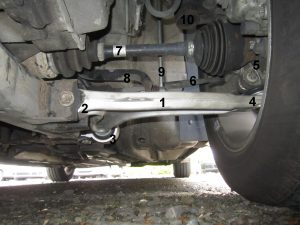Summary
Suspension wishbone or suspension arm?
Different types of suspension
What maintenance for the suspension component of a car?
Replacing the suspension
The suspension wishbone is the component that connects the wheel hub to the frame of a vehicle. This post will explain to you how it is a critical component in the handling of your car.
Suspension wishbone or suspension arm?
Suspension wishbone and control arms have the same role; it’s their shape that changes:
On the one hand, the suspension arm has an oblong shape; it is connected to the wheel pivot by a ball joint and the chassis generally by a silent block (often there is an additional attachment point that can connect with the stabilizer bar or the caster rod).

(From the above picture, suspension arm is indicated by no. 1)
On the other hand, the suspension wishbone consists of two attachment points on the frame side (silent blocks) and one attachment point on the hub side (ball joint).

(From the above picture, there are 2 suspension wishbones: 1 below and 1 above the spring)
Different types of suspension
Several materials can be used to make a car’s suspension:
– stamped sheet steel;
– an aluminum alloy;
– or cast iron.
There are mainly 2 technological solutions:
Double wishbone suspension: this type of suspension has 2 suspension wishbones: an upper wishbone and a lower wishbone (optimizing the train geometry’s angles for better handling).
The MacPherson suspension: in this case, only the lower link is present; it is the shock absorber body that provides the upper link. This option is more economical to manufacture and is mostly found on mass production vehicles. The road handling is nevertheless satisfactory.
What maintenance for the suspension component of a car?
Like any safety component, the suspension requires special attention. Deterioration can result in:
– Premature tire wear;
– a deterioration of road handling;
– and, in the worst case, the complete breakage of the part.
The control points are as follows:
– general aspect (presence of deformations, impact marks, corrosion, etc.);
– condition of the silent blocks (degradation of the rubbers);
– state of the suspension ball joint (deterioration of the protective casing).
Replacing the suspension
Depending on the model, the replacement operation may involve difficulties related to the suspension wishbone’s nesting or suspension arm with the other components of the suspension half-train. It may create safety problems for the operator:
– presence of compressed suspension springs requiring professional tools;
– transmission fixed to the hub may become disengaged and cause an oil leak at the gearbox.
Good to know: it is strongly recommended to entrust this operation to a qualified professional, especially since it will be necessary to check the trains’ angles with a geometry bench.
It will be possible for some vehicles to replace only the defective elements (ball joints, silent blocks) as long as they are removable and available as spare parts. This is often a delicate operation, as the fitting is done with a hydraulic press, as wrong handling can lead to a deformation of the suspension wishbone.
Good to know: there is no need for re-calibrating the wheel alignment if the suspension wishbone or the suspension arm is not in good shape.
Please note: It will also be necessary to replace the part on the opposite side for a defective component. Depending on the system’s degree of complexity, the price disparity for such a repair is significant: from $150 for a low-end vehicle (single-arm) to $800 for an Audi-type car (set of arms). It is therefore imperative to have several comparative estimates drawn up.
Hope the above has helped you get an idea of what a vehicle’s suspension is all about? Please, remember to share your comments in the section below.

